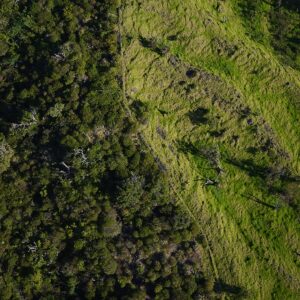
Photo credit: Art Medeiros. Native forest restoration and non-native pasture interface after 20 years of ecological restoration and recovering native Hawaiian dry forest at Auwahi forest restoration area II, 9 ha (23 acres), ca. 1,100 m (3,600 ft) elevation, southwest Haleakalā volcano, Maui island, Hawai’i.
Ecological restoration is the process of assisting the recovery of a native ecosystem that has been degraded, damaged, or destroyed.
Ecosystems are dynamic communities of plants, animals, and microorganisms interacting with their physical environment as a functional unit.
These communities can be damaged, degraded, or destroyed by human activity.
- Damage refers to an acute and obvious harmful impact upon an ecosystem such as selective logging, road building, poaching, or invasions of non-native species.
- Degradation refers to chronic human impacts resulting in the loss of biodiversity and the disruption of an ecosystem’s structure, composition, and functionality. Examples include: long-term grazing impacts, long-term over fishing or hunting pressure, and persistent invasions by non-native species.
- Destruction is the most severe level of impact, when degradation or damage removes all macroscopic life and commonly ruins the physical environment. Ecosystems are destroyed by such activities as land clearing, urbanization, coastal erosion, and mining.
The goal of ecological restoration is achieving substantial ecosystem recovery relative to an appropriate reference model, regardless of the time required to achieve recovery. Ecological restoration requires identifying the native ecosystem to be restored, as well as developing reference models for planning and communicating a shared vision of project objectives and targets. Reference models are developed using multiple sources of information. Best practice is to build empirical models based on information on specific ecosystem attributes obtained from multiple modern analogs or reference sites.
- An ecosystem is an assemblage of biotic and abiotic components in water bodies or on land in which the components interact to form complex food webs, nutrient cycles, and energy flows.
- A native ecosystem is an ecosystem comprising organisms that are known to have evolved locally or have recently migrated from neighboring localities due to changing environmental conditions including climate change. In certain circumstances, traditional cultural ecosystems or semi-natural ecosystems are considered to be native ecosystems. Presence of nonnative species or the expansion of ruderal species in native ecosystems are forms of degradation.
- A reference model is a model that indicates the expected condition that the restoration site would have been in had it not been degraded (with respect to flora, fauna and other biota, abiotic elements, functions, processes, and successional states). This condition is not the historic condition, but rather reflects background and predicted changes in environmental conditions
- A reference site is an extant intact site that has attributes and a successional phase similar to the restoration project site and that is used to inform the reference model. Ideally the reference model would include information from multiple reference sites
The practice of ecological restoration requires a high degree of ecological knowledge that can be drawn from practitioner experience, Traditional Ecological Knowledge, Local Ecological Knowledge, and scientific discovery. Restoration practitioners do not carry out the actual work of ecosystem recovery. Rather, they create the conditions needed for recovery so the plants, animals, and microorganisms can carry out the work of recovery themselves. Assisting recovery can involve actions ranging from removing invasive species to modifying landforms, vegetation, hydrology, or reintroducing wildlife.
When is ecological restoration complete?
Ecological restoration projects or programs include one or more targets that identify the native ecosystem to be restored (as informed by the reference model) and project goals that establish the level of recovery sought. When full recovery is the goal, an important benchmark is when the ecosystem demonstrates self-organization. At this stage, if unexpected barriers or lack of particular species or processes take recovery off course, further restoration actions may be required to ensure that the trajectory ultimately continues toward full recovery.
- Full recovery is defined as the state or condition whereby, following restoration, all key ecosystem attributes closely resemble those of the reference model. These attributes include absence of threats, species composition, community structure, physical conditions, ecosystem function, and external exchanges. Where lower levels of recovery are planned or occur due to resource, technical, environmental, or social constraints, recovery is referred to as partial recovery.
An ecological restoration project adopts the goal of achieving the highest level of recovery possible, relative to the six attributes of the reference ecosystem. Once fully recovered, any ongoing activities (e.g., to maintain disturbance regimes) would be considered ecosystem maintenance or management. Specific activities, such as prescribed fire or the control of invasive species, may be used in both restoration and maintenance phases of a project.
Restoration is not a substitute for conservation.
Ecological restoration is part of a larger set of ecosystem management practices designed to conserve and, where appropriate, sustainably utilize native ecosystems. It complements other conservation activities and nature-based solutions and vice versa. By doing so, global society must secure a net gain in the extent and functioning of native ecosystems by investing not only in environmental protection, but also in environmental repair, including ecological restoration. Therefore, restoration can help us move, globally, from centuries of cumulative environmental damage to land degradation neutrality and eventually to net ecological improvement.
You can learn more about ecological restoration in SER’s International Principles and Standards for the Practice of Ecological Restoration, available for free on our webpage: https://www.ser.org/page/standardsguidelinesprinciples.

